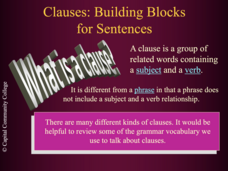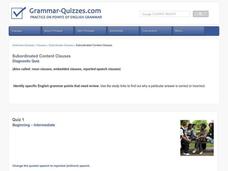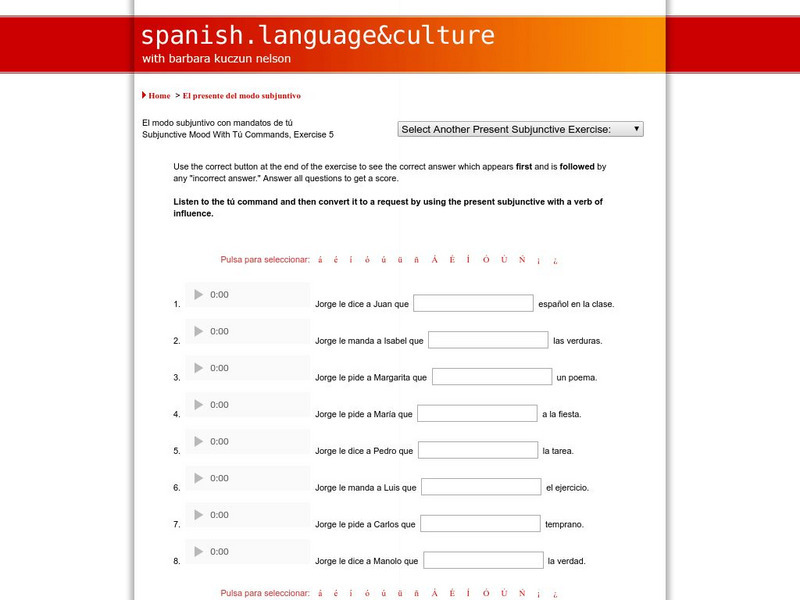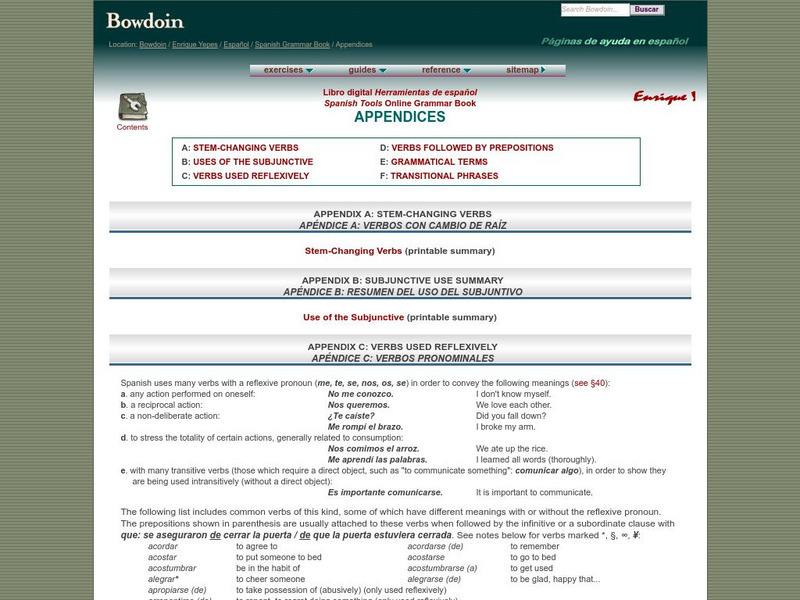Curated OER
Clauses: Building Blocks for Sentences
Colorfully animated and packed with engaging examples, this PowerPoint encourages to employ clauses to create a variety of sentence structures. Peer editing of sample paragraphs would provide an opportunity for guided practice with...
Curated OER
Subordinate (Dependent) Clause (Noun) Practice
In this noun clause worksheet, students learn to recognize a subordinate or dependent noun clause. Students analyze the examples before identifying the noun clauses in ten sentences.
Curated OER
Noun Clause as Object of a Sentence
In this noun clauses worksheet, students write a paragraph containing noun clauses and a topic sentence. Students write 3 noun clauses in their paragraph.
Curated OER
Noun Clauses
In this noun clauses activity, students choose the correct clause to complete the sentence which is a response to the one before it. Students complete 12 sentences.
Curated OER
Noun Clauses, Adjective Clauses, Or Adverb Clauses
In this clauses learning exercise, students fill in the blanks in 10 sentences with an appropriate clause. They tell which type of clause was used by writing either noun clause, adjective clause, or adverb clause on the blank lines in...
Curated OER
The Functions of Clauses
In this clauses worksheet, students choose the clause in bold that completes each sentence. Students check their answer to complete the online quiz. Students complete 10 examples.
McGraw Hill
Combining Sentences Using Subordination
In this sentence combining worksheet, students combine sentences using subordinating clauses. Students use adjective clauses, adverb clauses, or noun clauses to combine the sentences.
Curated OER
Clauses: The Trilogy
In this clauses review worksheet set, students go over the proper use of the trilogy of clauses. They review noun clauses, adverb clauses, and adjective clauses by reading their definitions and examples of their usage. There are no...
Capital Community College Foundation
Guide to Grammar and Writing: Abstract Nouns
The composition of a noun is more than just a person, place or thing. Use this resource to study examples of nouns and their many uses.
Colby College
Spanish Language & Culture: Subjunctive Adverb Clauses (Part 2)
Students practice using the present subjunctive, the present indicative, or the infinitive after certain conjunctions. This exercise helps fortify the use of the subjunctive in adverbial clauses. Answers may be checked and corrected.
Colby College
Spanish Language & Culture: Subjunctive Noun Clauses #4
This exercise practices the present subjunctive with verbs of influence: aconsejar, decir, insistir, mandar, necesitar, pedir, preferir, prohibir, querer, recomendar, rogar, and sugerir. An English translation is provided as a foundation...
Colby College
Spanish Language & Culture: Subjunctive With Commands
Hear a "tu" command and complete the indirect command with the correct form of the verb in the present subjunctive. Answers may be checked and corrected.
Colby College
Spanish Language & Culture: Subjunctive Verbs of Emotion
With the English translation as a guide, the student completes the Spanish equivalent by conjugating the verb of emotion into the present indicative and the verb in the noun clause into the present subjunctive. Good practice for spelling...
Study Languages
Study Spanish: Subjunctive: Impersonal Expression
Great explanation of the subjunctive mood used in impersonal expressions and contrasted to contradictory applications in the indicative. Ample examples illustrate the difference between these two moods. A useful list of impersonal...
Study Languages
Study Spanish: Subjunctive: Ignorance or Doubt
Great explanation of the subjunctive mood used to express ignorance or doubt and contrasted to contradictory applications in the indicative. Ample examples illustrate the difference between these two moods. A useful list of expressions...
Study Languages
Study Spanish: Subjunctive: Desire
Great explanation of the subjunctive mood used to express desire and contrasted to contradictory applications in the indicative. Ample examples illustrate the difference between these two moods.A useful list of expressions that indicate...
Capital Community College Foundation
Guide to Grammar and Writing: Nouns
A complete tutorial on identifying and using nouns that starts with identifying the nouns in "My Favorite Things" from The Sound of Music. Includes links to other noun grammar pages.
Indiana University
Iu: Juan M. Soto Reglas Subjuntivo Creer/dudar
Concise, but thorough Spanish explanation of the subjunctive in the noun clause with expressions of doubt and disbelief. Great review for advanced students or teachers who want a quick review. Links are also available to interactive...
University of Ottawa (Canada)
University of Ottawa: Sass: Sentence Structure [Pdf]
This online writing guide defines independent and dependent clauses and explains how dependent clauses are used in sentences. With examples. [PDF]
Robin L. Simmons
Grammar Bytes: The Clause
This site provides definitions and examples of main (independent) clauses, subordinate (dependent) clauses, relative clauses, and noun clauses. It also offers instructions on using these clauses in sentences.
Other
Bowdoin: Review of Uses of the Subjunctive
Review the uses of the subjunctive and see examples of each use in English and Spanish.
Colby College
Spanish Language & Culture: Present Perfect Subjunctive
Online exercises that test your knowledge in the present perfect subjunctive tense versus the indicative. Click on the question mark if you're having difficulty filling in the blank. Click on the underlined words to get a photo...
Colby College
Spanish Language & Culture: Subjunctive Verbs of Doubt
A Spanish word bank of verbs of doubt is used to complete Spanish translations of the main clause. The student practices conjugating these verbs in the present indicative tense. Answers may be checked and corrected. The present...
The Tongue Untied
The Tongue Untied: Nouns
Defines the many rules that govern the use of nouns, including their use as subjects, and the requirements for agreement; predicate nominatives; four types of objects (direct object, indirect object, object of preposition, and object of...























